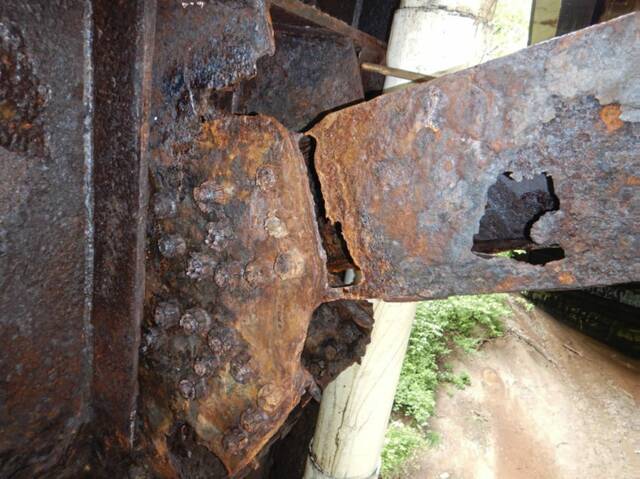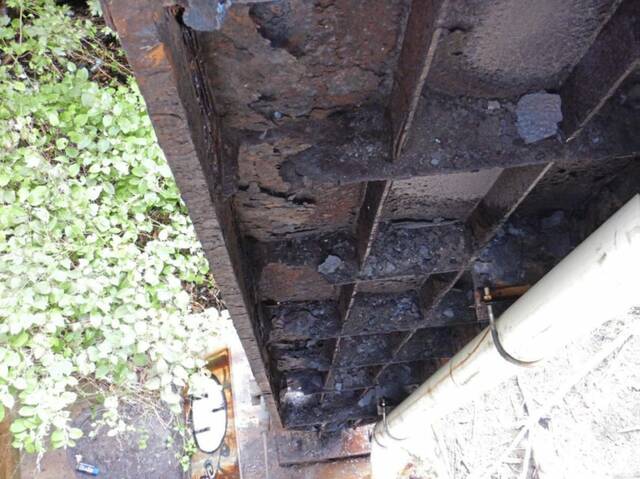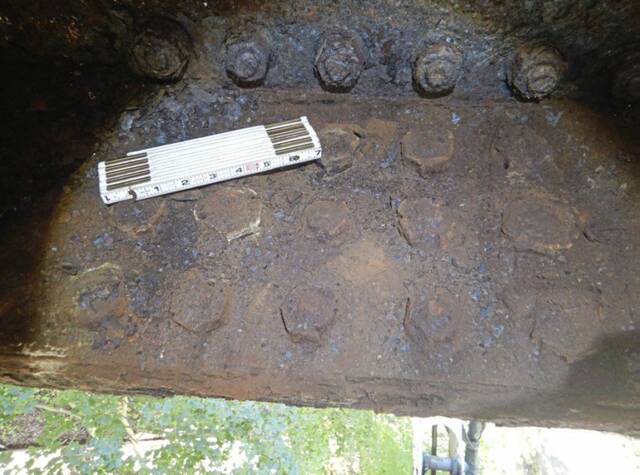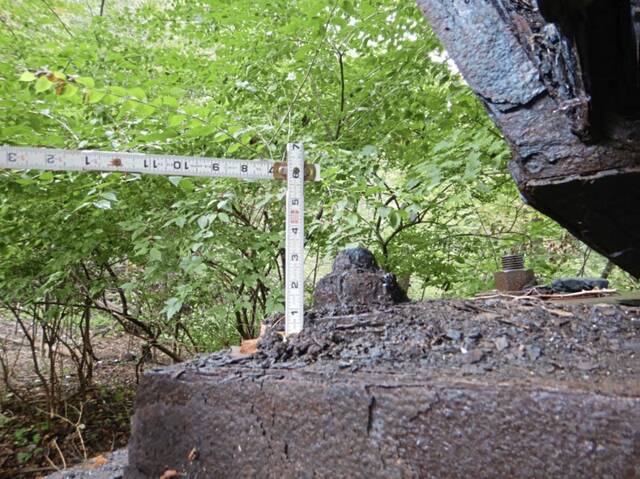Fern Hollow Bridge inspection troubling but did not suggest imminent danger, experts say
Three months before Pittsburgh’s Fern Hollow Bridge collapsed 100 feet into a ravine below, inspectors again rated the span structurally deficient.
Following a routine inspection in late September, a report submitted to the city and PennDOT gave the bridge an overall rating of 4 on a 9-point scale, said Penn State University engineering professor Kostas Papakonstantinou.
Although a bridge with an overall score of 4 or below is considered to be structurally deficient, Papakonstantinou said, “‘Structurally deficient’ doesn’t mean the bridge is in imminent danger of collapse.”
It could mean that traffic flow should be reduced or that the load rating should be reevaluated, he said.
In the case of the Fern Hollow Bridge, neither of those things happened.
The report listed nothing in need of “immediate improvement,” which would require prompt action by officials.
Eight items were listed as “short-term improvements” to be made within the next two years, including recommendations to paint areas of the bridge with leaks, replace stiffeners used to prevent buckling and weld new steel plates on all four legs of the bridge to repair holes there.
Observations in the inspection report that sounded scariest — 50% section loss on some bolts, all four legs having transverse stiffeners that were completely rusted through and severe corrosion and holes — were not enough to warrant recommendations of immediate action.
“After the fact, it’s easy to say something went wrong here,” Papakonstantinou said, adding that’s not necessarily the case.
Every bridge inspection report relies on the analysis from previous years’ reports. That means, according to Papakonstantinou, that you can’t necessarily fault any one agency, company or person for the bridge failure. In the most recent Fern Hollow report, provided by PennDOT, the name of the company that completed the inspection was redacted.
PennDOT spokeswoman Alexis Campbell said she could not talk about the report’s findings.
“PennDOT is not in a position at this point to discuss the inspection that was performed and its recommendations because the investigation … is not completed,” she said. “It would be premature for PennDOT, or anyone for that matter, to draw conclusions and provide commentary about causation or remedial measures.”
It could take up to two years for the full, federal investigation into the collapse to be completed.
“This could have been a terrible disaster, but due to luck that didn’t happen,” Papakonstantinou said.
‘Troubling signs’
The 447-foot-long, four-lane Fern Hollow Bridge was built in 1970 and carried both pedestrians and vehicle traffic over Fern Hollow and Nine Mile Run below. About 14,000 cars passed over it daily, according to PennDOT.
When it collapsed around 6:40 a.m. Jan. 28, there were only six vehicles – including an articulated Port Authority bus – on it. Nine people were injured.
The National Transportation Safety Board and Federal Highway Administration investigation into the collapse continues, but in photos taken by cameras on the bus, the bridge deck can be seen beginning to separate at the east expansion joint on the Point Breeze side of the bridge at the same time as the west end of the bridge on the Squirrel Hill side can be seen falling off the west abutment.
NTSB’s preliminary report, released last month, said investigators had not found evidence of “widespread deficiencies” in the bridge’s superstructure.
The National Bridge Inventory Data shows the Fern Hollow Bridge had been rated as poor since 2011.
The inspection report from the fall cited the superstructure of the bridge and areas underneath the bridge’s deck as particular areas of concern, Papakonstantinou said.
He noted fracture cracks mentioned in the report, saying that if such cracks affect critical parts of a bridge such as columns or beams, it increases the risk of a collapse or partial collapse.
The report said the bridge’s legs were severely deteriorated, and tensioning cables were installed between 2007 and 2009 to compensate.
Lauren Linderman, an engineering professor at the University of Minnesota, said the report raised questions that needed to be answered.
“I am surprised by the level of degradation of the structure,” she said.
Linderman pointed to the level of corrosion, likely caused by a path of runoff water, as well as the weather the bridge was subjected to, including extreme temperature swings.
Papakonstantinou also raised concern about the removal in 2019 of an X brace that had been completely lost to corrosion. The brace was not replaced, he said.
“Perhaps the tensioning cables were meant to do this job,” he said. “Why didn’t that X brace get replaced?”
Papakonstantinou said that the load rating analysis for the bridge — which determines how much weight it can carry — was not reevaluated after 2019. But he also noted that the most recent report showed that findings from years past, such as cracks that had been previously identified, had not worsened.
Some bolts at the girders were deteriorated so badly that they had 70% section loss, he said.
“These are some troubling signs because they carry the load,” Papakonstantinou said.
He noted that the weight capacity on the bridge had been reduced in 2014, and the bridge was subject to annual — and the standard biannual — inspection because of safety concerns.
Linderman believes that, based on the inspection report, the load posting for the structure should have been reevaluated.
“I don’t know if I would close the bridge immediately,” she said. “I’d do an analysis pretty quick with what you’re seeing.”
That means looking at what the bridge can carry versus the demand on the system.
“That’s the big question when you deal with ‘how do we manage our infrastructure?’” she said. “What’s the community impact if that element were not to be in service anymore? What level of repair is needed to make it acceptable.”
Both experts said that the fall inspection report was well-done. And while it raised serious concerns, it did not necessarily mean the bridge should have been shut down.
“Despite all these problems, it’s still a 4,” Papakonstantinou said. “I agree with their ratings.
1 in a million
The Federal Highway Administration’s National Bridge Inventory shows Pennsylvania has 23,166 bridges. Of those, 3,198 — or 13.8% — are classified as structurally deficient.
In the 18th Congressional District, in which Fern Hollow Bridge was located, there are 1,290 bridges and 9.5% of them are deemed structurally deficient.
Fifty-three of those 123 bridges had been given load restrictions, which would affect either the size or weight of vehicles crossing.
“There are risks involved with these old bridges,” Papakonstantinou said. “Unfortunately, we cannot replace them all at the same time.”
He said it is extremely rare for a bridge to fail, and that the chances of it are one in a million.
“We don’t want to think of it this way, but unfortunately, it’s a reality,” Papakonstantinou said.
Under federal law, PennDOT has oversight responsibility for approximately 6,600 locally owned bridges longer than 20 feet. All inspection reports are provided to PennDOT, but maintenance and repairs are the responsibility of the bridge owner.
If there are urgent maintenance needs, PennDOT notifies the bridge owner and tracks completion. Anything non-urgent is not tracked and is the responsibility of the bridge owner.
In the case of the Fern Hollow inspection report from last fall, there were no urgent priority needs.
The best possible condition for a bridge is a 9, Papakonstantinou said. Anything less than a 4, he continued, will immediately raise a red flag and require imminent intervention.
“A 3 means you absolutely will get attention within two years,” he said. “Lower than 3, things get ugly.”
Papakonstantinou noted that Fern Hollow Bridge failed with just a few cars on it, so that doesn’t necessarily mean that the weight on it was the problem. The bridge had snow on it at the time of the collapse, as well.
“The cracks and the load do not appear to be the problem here,” Papakonstantinou said.
Papakonstantinou said that government agencies update their priority list for bridges every two years based on inspection reports and other findings.
Often, Papakonstantinou said, after a disaster like this one, criteria and codes get updated to try to avert the next one.
“This incident could be a starting point to get regulations updated — like load-rating analysis,” he said.
He estimated that a full and complete investigation into what caused the collapse will take two years.
In the meantime, the City of Pittsburgh last month announced a new Comprehensive Bridge Asset Management Program. The proposal is to include a review of the current condition of the 150 city-owned bridges and recommendations for immediate additional inspections and repairs, maintenance and preservation.
Paula Reed Ward is a TribLive reporter covering federal and Allegheny County courts. She joined the Trib in 2019 after spending nearly 17 years at the Pittsburgh Post-Gazette, where she was part of a Pulitzer Prize-winning team. She is the author of “Death by Cyanide.” She can be reached at pward@triblive.com.
Remove the ads from your TribLIVE reading experience but still support the journalists who create the content with TribLIVE Ad-Free.






